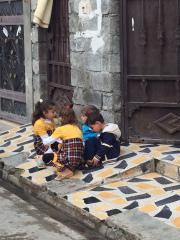I am in Northern Iraq with a small group under the auspices of Christian Aid. Yesterday morning we met a group involved in reconstruction and development work in Duhok before splitting into three groups to visit a Christian refugee family, a Yazidi refugee family and a Syrian Sunni refugee family.
I went with two colleagues to visit the Syrian Muslims. We sat in their rented home and listened to their story. Having joined in the demonstrations against the Assad regime in 2011, they were forced to flee once the violence began. They left Damascus, stayed in the border with Iraq in a camp, hoping they would be able to return to their home before long. In 2012 they gave up and ended up in Duhok. They were clear that they are Syrian first and Kurdish second.
Their youngest son is ill and cannot get adequate treatment. He is fourteen years old and has had no schooling since 2012. His father is not allowed to work. There is another son and two daughters. They want to return to Syria, but they have no hope. Each day is hemmed in by unimaginable and unmeasurable helplessness and hopelessness. Their hospitality was great, their hope tiny. Their dignity was intact.
How do you live hopefully, one day at a time, when there is nothing to do, no work, no education for your children, no home to return to, and no idea if some sort of solution might come in one month, one year, one decade, or never?

This visit was followed in the evening by a meeting with the Iraq director of MAG (Mines Advisory Group). They have been here for 23 years, clearing mines and improvised explosive devices (IEDs) from the 1980s (Iran-Iraq War), the 1990s (Gulf War), the 2000s (now Daesh), and Saddam mining his own country along borders. There are 20 million mines in 3,500 minefields. This has, for example, turned the breadbasket of Iraq – the Nineveh Plain – into a disaster zone (adding to the desertion of almost the entire Christian population under Daesh). Despite more than 300 mine clearance engineers working continuously, 2015 saw 72 civilian casualties, 42 of them fatal. In Sinjar alone there were 28 civilian casualties, 8 of them fatal.
How are people to “go home” when their homes have been destroyed, social infrastructure wiped out, and the only source of sustenance – the land – mined?
What is most clear here is the destruction of trust between communities that previously had cohabited for centuries. It is hard to see a future.
More anon.

